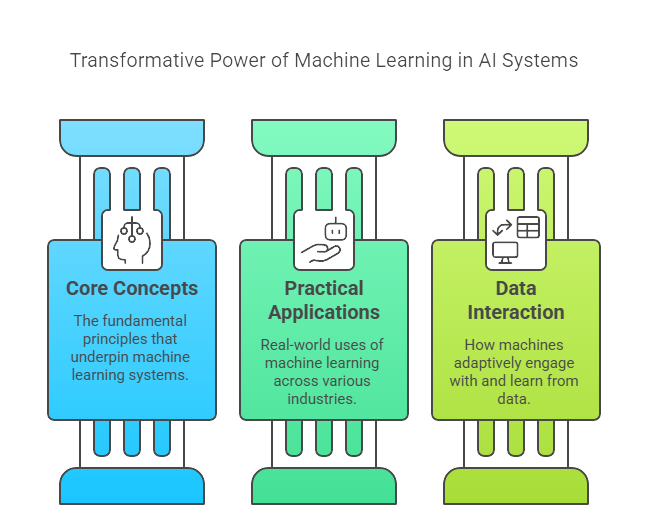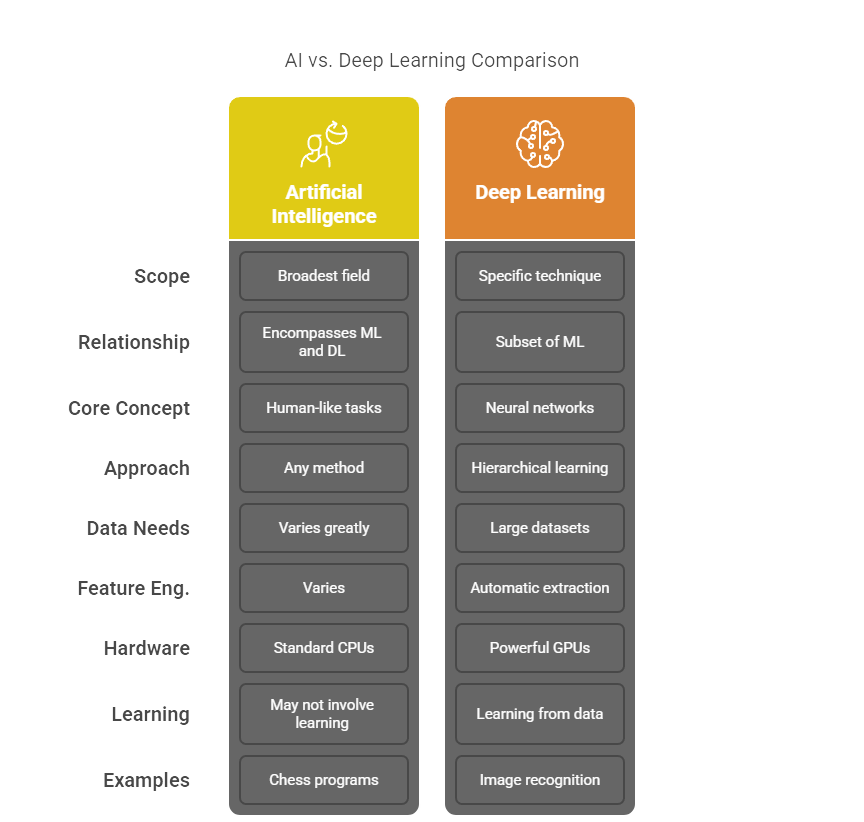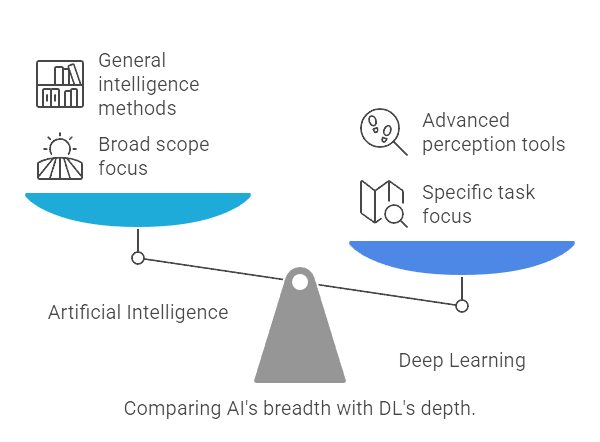Summary: Artificial Intelligence (AI) and Deep Learning (DL) are often confused. AI vs Deep Learning is a common topic of discussion, as AI encompasses broader intelligent systems, while DL is a subset focused on neural networks. This guide clarifies their distinctions, applications, and future implications in technology and business.
Introduction
In today’s rapidly evolving technological landscape, terms like Artificial Intelligence (AI), Machine Learning (ML), and Deep Learning (DL) are thrown around constantly. They appear in news headlines, product descriptions, and futuristic discussions.
While often used interchangeably in casual conversation, they represent distinct concepts with a specific hierarchical relationship. Understanding the difference between AI vs Deep Learning is crucial not just for tech enthusiasts but for anyone curious about the technologies shaping our future.
Is Deep Learning just another name for AI? Is all AI Deep Learning? What sets them apart? This blog post aims to demystify these powerful concepts. We’ll break down Artificial Intelligence as the overarching goal, introduce its key subset Machine Learning, and then dive deep into Deep Learning, explaining its unique capabilities and how it relates to the others.
Get ready to explore the fascinating world behind the buzzwords, complete with practical AI examples and Deep Learning examples.
Key Takeaways
- AI Encompasses Broad Applications: Includes machine learning and more.
- Deep Learning Focuses on Neural Networks: Specializes in complex pattern recognition.
- AI Drives Automation and Efficiency: Improves processes across industries.
- DL Enhances Predictive Analytics: Excels in image and speech recognition tasks.
- Both Drive Technological Innovation: Transform industries with intelligent systems.
Artificial Intelligence (AI): The Grand Vision

Think of Artificial Intelligence as the broadest term, the ultimate dream, the big umbrella concept. At its core, Artificial Intelligence refers to the science and engineering of creating machines and software capable of exhibiting intelligent behaviour.
It’s about building systems that can perform tasks that typically require human intelligence. What kind of tasks? These include:
- Reasoning: Drawing logical conclusions from information.
- Problem-Solving: Finding solutions to complex challenges.
- Learning: Acquiring knowledge and skills from experience or data.
- Perception: Understanding the world through sensory input (like vision or sound).
- Planning: Devising sequences of actions to achieve goals.
- Language Understanding: Processing and interpreting human language (Natural Language Processing – NLP).
- Knowledge Representation: Storing and organizing information effectively.
The goal of Artificial Intelligence isn’t necessarily to replicate the human mind perfectly but to create systems that can act intelligently and rationally to solve problems effectively. AI is a vast field encompassing many different approaches and techniques, developed over decades.
Early AI Approaches
Early Artificial Intelligence systems often relied on explicitly programmed rules. Think of “expert systems” from the 1980s, designed to mimic the decision-making ability of a human expert in a specific domain (like medical diagnosis or financial planning).
These systems used vast databases of knowledge and complex if-then rules coded by humans. While impressive for their time, they were often brittle – they struggled with unforeseen situations not covered by the rules and required immense human effort to create and maintain.
A simple example could be an early chess-playing program that evaluated moves based on predefined rules and search algorithms. Understanding this broad scope is key to grasping the difference between Artificial Intelligence vs Deep Learning.
Introducing Machine Learning (ML): AI That Learns

As the limitations of purely rule-based Artificial Intelligence became apparent, researchers sought ways for machines to learn automatically from data, rather than being explicitly programmed for every eventuality. This led to the rise of Machine Learning (ML).
Machine Learning is a subset of Artificial Intelligence. It’s a specific approach to achieving AI. Instead of hard-coding rules, ML algorithms are designed to learn patterns and make predictions or decisions based on data they are “trained” on.
The Core Idea of Machine Learning: Give the machine data, and let it figure out the rules itself.
Think about a spam filter for your email:
- Traditional AI (Rule-Based): You could try to write rules like “IF email contains ‘free money’ AND ‘click here’, THEN mark as spam.” This is difficult to maintain as spammers change tactics.
- Machine Learning Approach: You feed an ML algorithm thousands of emails already labeled as “spam” or “not spam.” The algorithm analyzes these examples and learns the characteristics (words, phrases, sender patterns) strongly associated with spam. It builds its own internal model (rules, essentially) to classify new, unseen emails.
ML algorithms are incredibly diverse, including techniques like:
- Linear Regression
- Logistic Regression
- Decision Trees
- Support Vector Machines (SVM)
- Naive Bayes
- K-Means Clustering
Machine Learning examples are everywhere: recommendation engines on Netflix or Amazon (learning your preferences from viewing/purchase history), predictive text on your smartphone, fraud detection systems, and medical diagnostic tools analysing patient data.
ML enabled a huge leap forward in Artificial Intelligence capabilities by allowing systems to adapt and improve from experience (data).
Deep Learning (DL): A Powerful Engine within Machine Learning

Now, where does Deep Learning fit in? Deep Learning is a specialized subset of Machine Learning. Just as ML is a way to achieve AI, DL is a specific technique within ML that has proven remarkably effective, particularly for certain types of complex problems.
The Inspiration: The Human Brain
Deep Learning is heavily inspired by the structure and function of the human brain, specifically the network of neurons. It utilizes complex structures called Artificial Neural Networks (ANNs). While the idea of ANNs has been around for decades, Deep Learning specifically refers to ANNs with multiple layers of interconnected nodes or “neurons” – hence the term “deep.”
How Deep Learning Works
Imagine processing an image to identify a cat.
1: Input Layer: Receives the raw pixel data of the image.
2: Hidden Layers (Multiple – “Deep”): Each layer processes the output from the previous layer, learning increasingly complex features.
- The first hidden layer might learn to detect simple edges and corners.
- The next layer might combine edges to recognize basic shapes (circles, rectangles).
- Subsequent layers might combine shapes to identify parts of the cat (ears, tail, eyes).
- Deeper layers combine these parts to recognize the overall concept of a “cat.”
3: Output Layer: Produces the final result (e.g., a probability score indicating whether the image contains a cat).
The Key Differences Between Artificial Intelligence and Deep Learning

Artificial Intelligence (AI) and Deep Learning (DL) differ significantly in scope, complexity, and applications. AI is a broad field focused on simulating human intelligence, encompassing techniques like decision trees and rule-based systems.
In contrast, DL is a specialized subset of Machine Learning (ML) that uses multi-layered neural networks to recognize patterns and automate complex tasks.
AI often requires manual feature engineering and can work with smaller datasets, operating efficiently on standard CPUs. DL, however, extracts features automatically, demands large datasets for accuracy, and relies on GPUs or TPUs for high computational power.
While AI has broader applications such as robotics and natural language processing (NLP), DL excels in focused areas like image detection and generative AI models. These distinctions highlight how AI serves as an overarching concept, with DL providing advanced capabilities within specific domains.
Why Now? The Rise of Deep Learning
While the concepts behind neural networks aren’t new, Deep Learning has experienced explosive growth in the last decade or so due to a confluence of factors:
Big Data
DL models thrive on vast amounts of labelled data for training. The digital age generated unprecedented volumes of data (images on social media, text online, sensor data).
Computational Power
Training deep neural networks is computationally intensive. The development of powerful Graphical Processing Units (GPUs), initially designed for gaming, provided the parallel processing power needed to train these complex models efficiently.
Algorithmic Advancements
Researchers developed improved algorithms, network architectures (like Convolutional Neural Networks – CNNs for images, Recurrent Neural Networks – RNNs for sequences), and training techniques that made DL more effective and stable.
Deep Learning Examples
Deep Learning is the driving force behind many of the most impressive AI advancements we see today:
Image Recognition
Identifying objects, faces, and scenes in photos and videos (used in social media tagging, medical image analysis, autonomous vehicles). This is a classic Deep Learning example.
Speech Recognition
Converting spoken language into text (powering virtual assistants like Siri, Alexa, Google Assistant).
Natural Language Processing (NLP)
Understanding and generating human language, enabling machine translation (Google Translate), sentiment analysis, chatbots, and text summarization. Many advanced NLP tasks heavily rely on Deep Learning.
Autonomous Vehicles
Processing sensor data (cameras, LiDAR) to perceive the environment, identify obstacles, and make driving decisions.
Drug Discovery and Genomics
Analysing complex biological data to identify potential drug candidates or understand genetic sequences.
Recommendation Systems
Creating highly personalized recommendations by understanding subtle patterns in user behaviour (often supplementing or replacing traditional ML methods).
The Hierarchy: AI > ML > DL
Let’s visualize the relationship clearly:
- Artificial Intelligence (AI): The overarching field/goal of creating intelligent machines. It encompasses all approaches, including ML and DL.
- Machine Learning (ML): A subset of AI. Focuses on algorithms that learn from data without explicit programming. It includes DL but also many other techniques.
- Deep Learning (DL): A subset of ML. Uses deep artificial neural networks with multiple layers to learn complex patterns and features automatically from large datasets. It’s a powerful technique within ML for achieving AI.
Think of it like Russian nesting dolls: AI is the largest doll, ML is inside AI, and DL is inside ML. Every Deep Learning system is also Machine Learning and Artificial Intelligence. However, not all AI is ML, and certainly, not all ML is DL. Understanding this hierarchy is central to grasping the difference between AI vs Deep Learning.
Conclusion
Artificial Intelligence represents the grand ambition of imbuing machines with intelligence. Machine Learning provided a powerful paradigm shift, enabling systems to learn from data.
Deep Learning, as a sophisticated subset of Machine Learning utilizing deep neural networks, has unlocked unprecedented capabilities in areas like perception and language, driving many of the AI breakthroughs captivating the world today.
They are not competing concepts but rather nested layers of a fascinating and rapidly advancing field. Deep Learning provides powerful engines for specific tasks within the broader quest for Artificial Intelligence.
While DL is currently making headlines, ongoing research across the entire spectrum of AI, including other ML techniques, symbolic reasoning, and hybrid approaches, continues to push the boundaries of what machines can achieve.
Understanding the difference between Artificial Intelligence vs Deep Learning helps us appreciate both the specific power of techniques like DL and the enduring, expansive vision of AI itself.
Frequently Asked Questions
Is Deep Learning the same as Artificial Intelligence?
No. Deep Learning is a specific technique within Machine Learning, which itself is a subfield of the much broader field of Artificial Intelligence. Think of AI as the overall goal, and DL as one powerful tool used to achieve parts of that goal.
Does all modern AI use Deep Learning?
Not necessarily. While Deep Learning powers many high-profile AI applications (like image recognition), many other AI systems use traditional Machine Learning algorithms or even older rule-based techniques, depending on the specific problem they are designed to solve. AI is a diverse field.
What is the Main Advantage of Deep Learning over Other AI/ML methods?
Deep Learning’s primary advantage is its ability to automatically learn complex patterns and hierarchical features directly from large amounts of raw, unstructured data (like images or text), often eliminating the need for manual feature engineering required by traditional Machine Learning methods.



